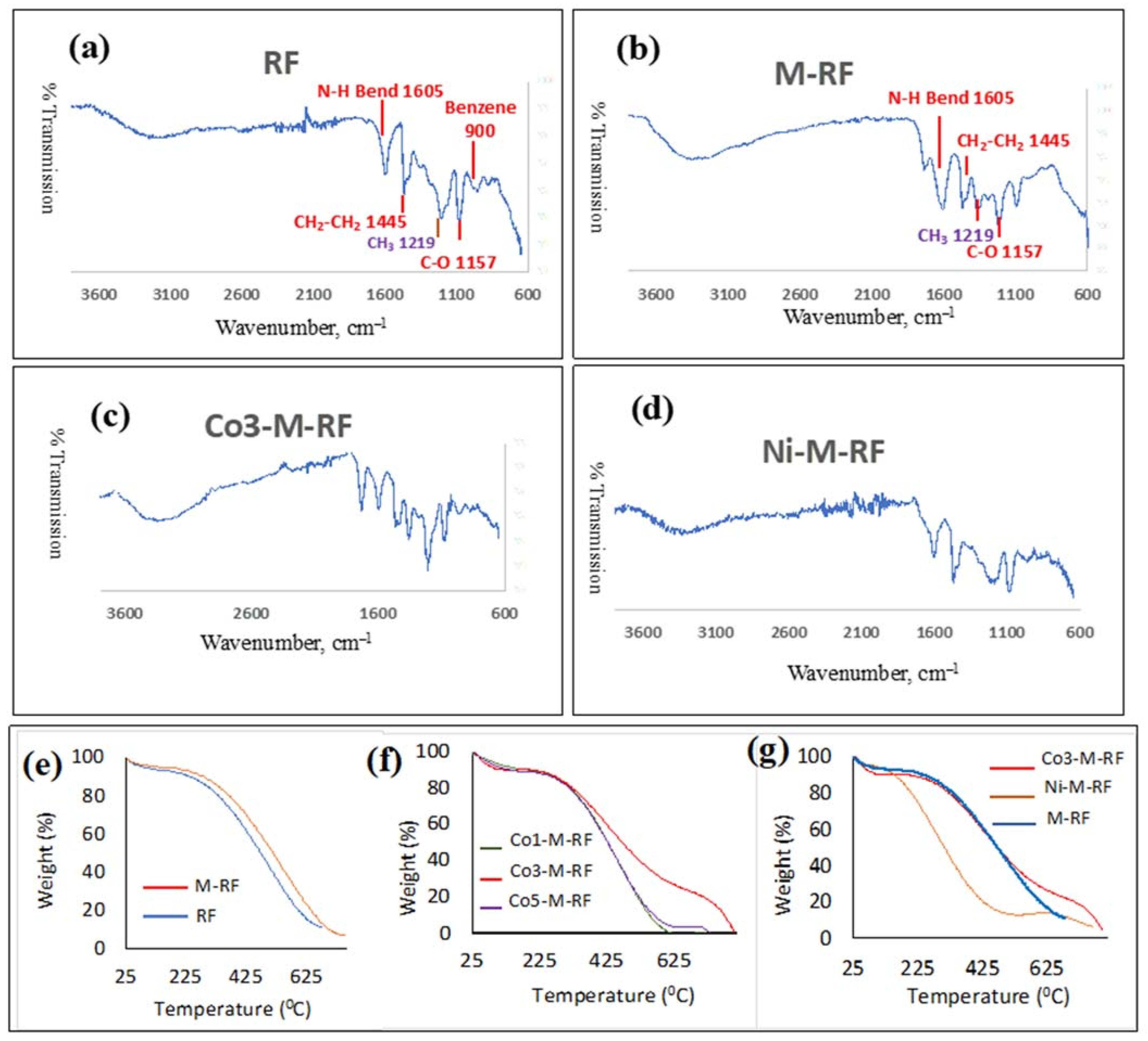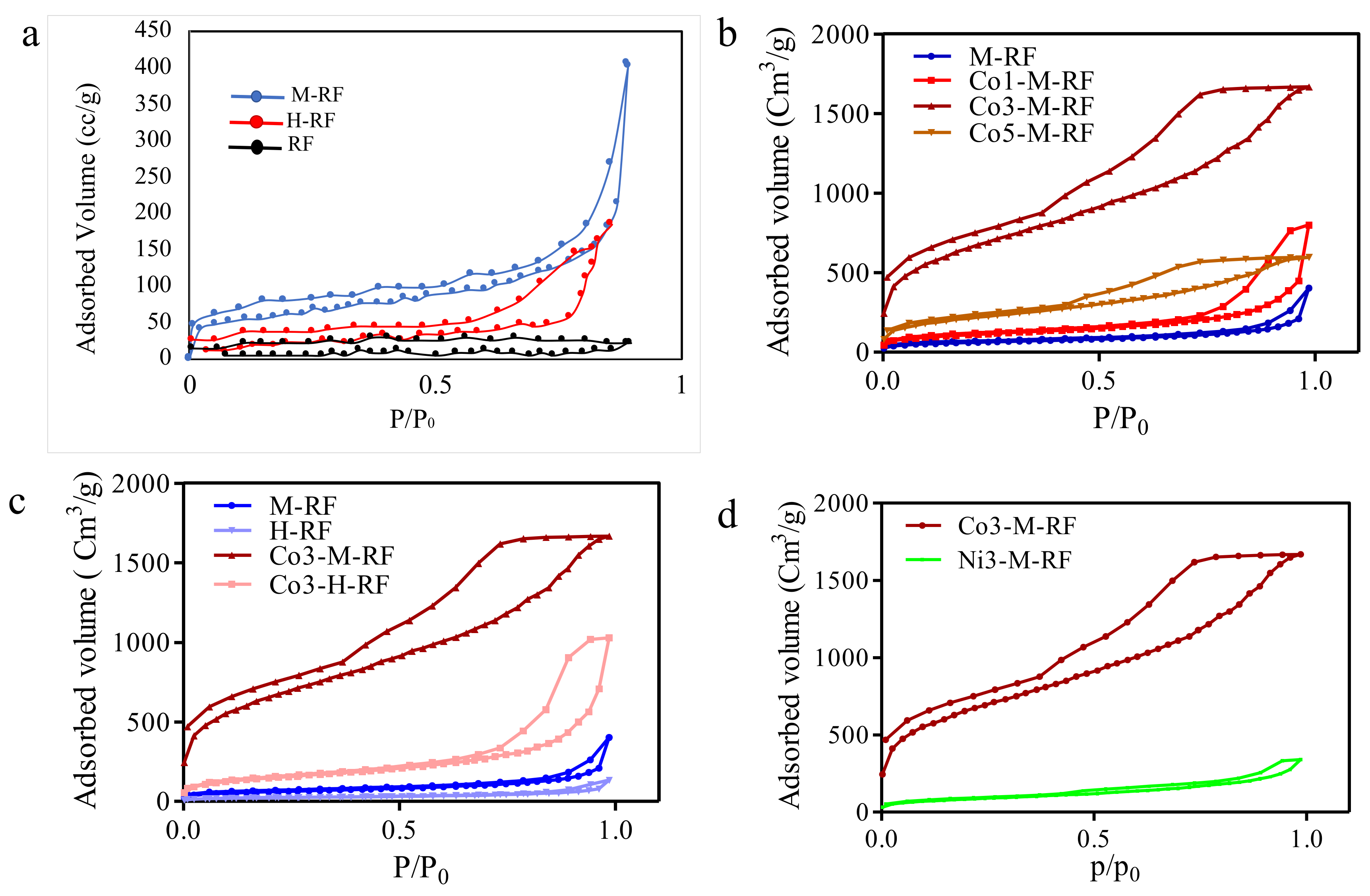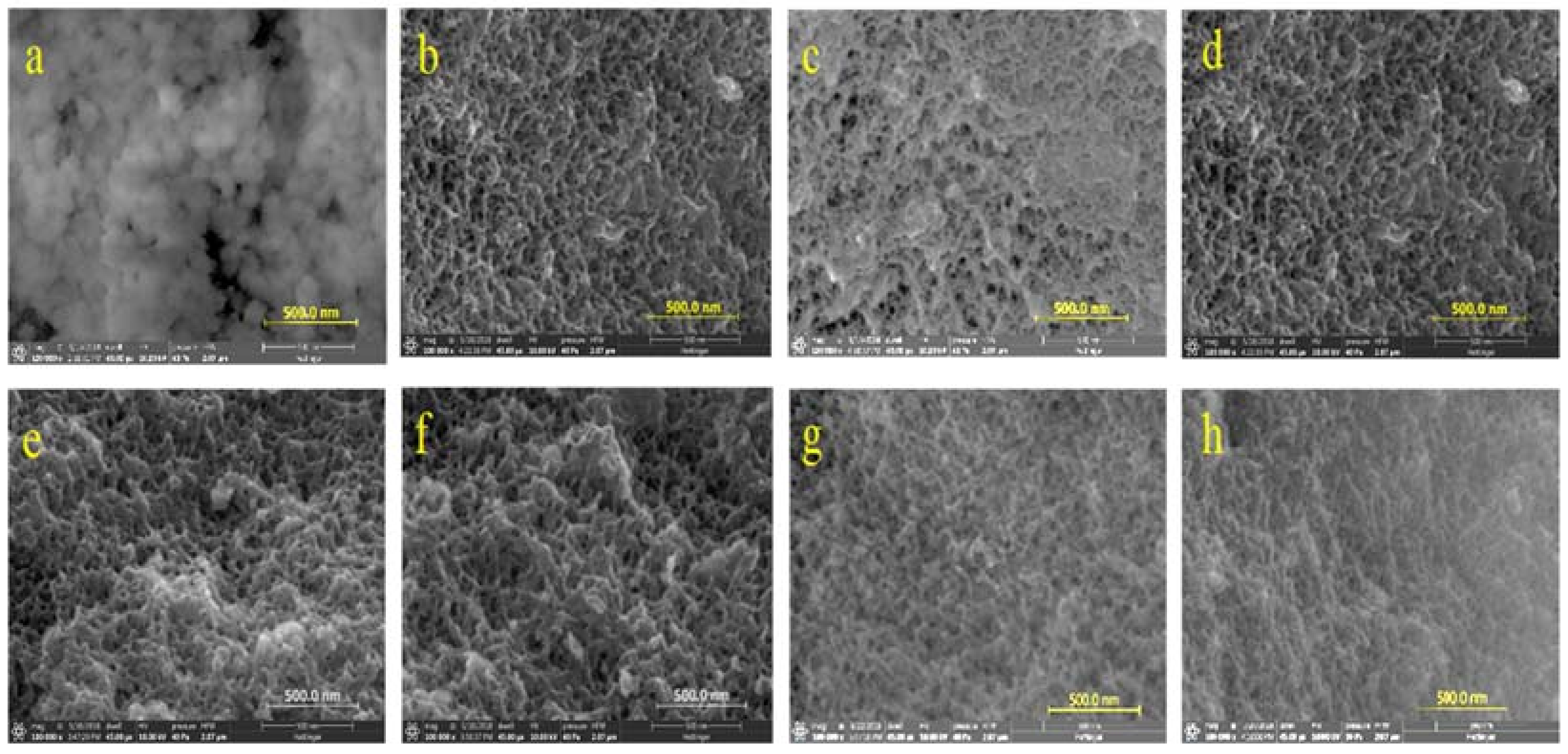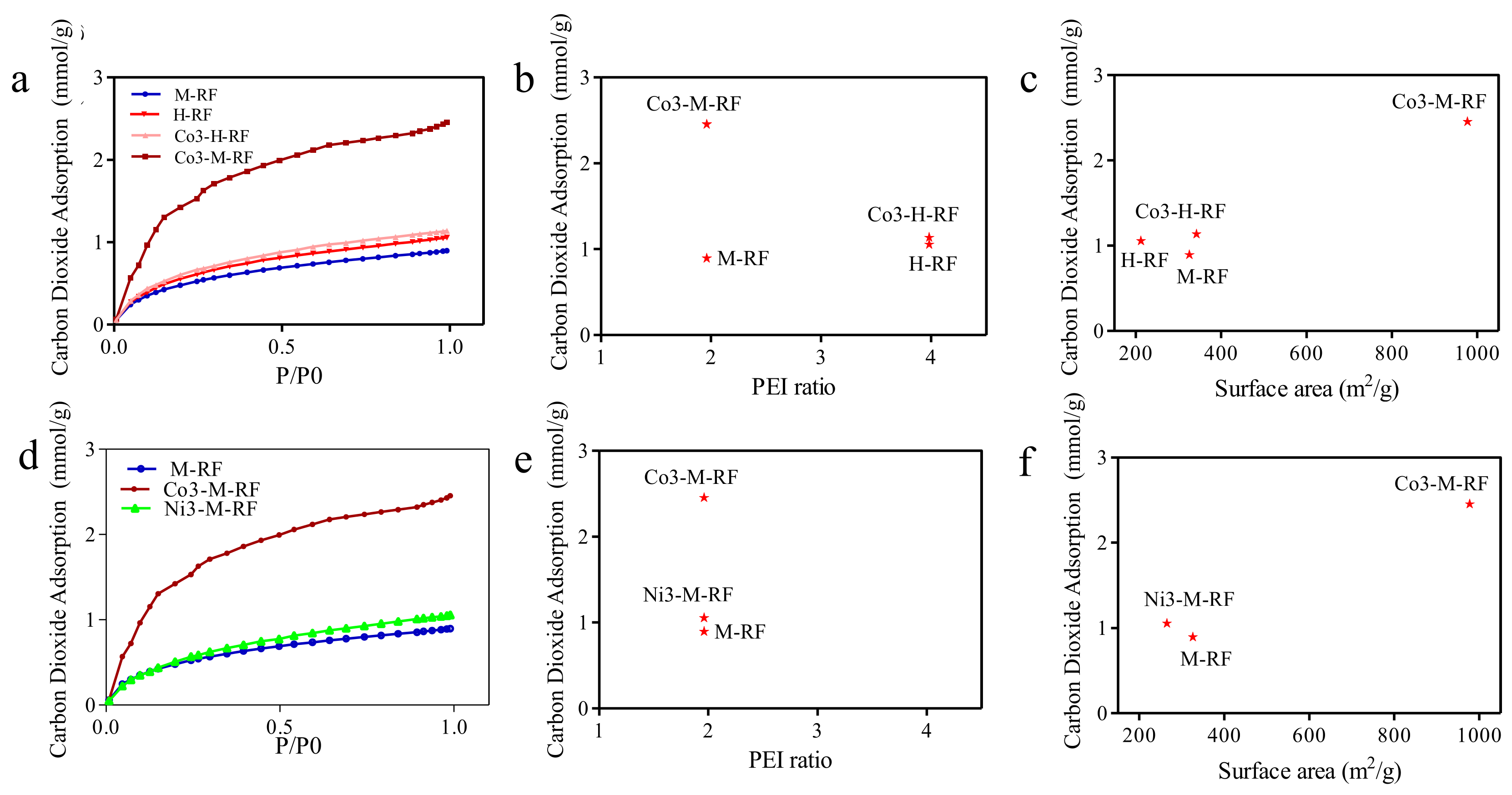Developing Eco-Friendly and Cost-Effective Porous Adsorbent for Carbon Dioxide Capture
Abstract
1. Introduction
2. Results
2.1. Chemical Structure and Thermal Stability
2.2. Surface Area and Pore Structure
2.3. Carbon Dioxide Adsorption
3. Discussion
4. Materials and Methods
4.1. Materials
4.2. Synthesis of My-x-RFs
4.3. Characterization
4.4. Carbon Dioxide Adsorption
5. Conclusions
Supplementary Materials
Author Contributions
Funding
Data Availability Statement
Acknowledgments
Conflicts of Interest
Sample Availability
References
- Oh, T.H. Carbon capture and storage potential in coal-fired plant in Malaysia—A review. Renew. Sustain. Energy Rev. 2010, 14, 2697–2709. [Google Scholar] [CrossRef]
- Liu, X.; Zhu, L.; Wang, H.; He, G.; Bian, Z. Catalysis performance comparison for electrochemical reduction of CO2 on Pd–Cu/graphene catalyst. RSC Adv. 2016, 6, 38380–38387. [Google Scholar] [CrossRef]
- Maina, J.W.; Pozo-Gonzalo, C.; Kong, L.; Schütz, J.; Hill, M.; Dumée, L.F. Metal organic framework based catalysts for CO2 conversion. Mater. Horiz. 2017, 4, 345–361. [Google Scholar] [CrossRef]
- Yaashikaa, P.; Kumar, P.S.; Varjani, S.J.; Saravanan, A. A review on photochemical, biochemical and electrochemical transformation of CO2 into value-added products. J. CO2 Util. 2019, 33, 131–147. [Google Scholar] [CrossRef]
- Chen, C.S.; Handoko, A.D.; Wan, J.H.; Ma, L.; Ren, D.; Yeo, S. Stable and Selective Electrochemical Reduction of Carbon Dioxide to Ethylene on Copper Mesocrystals Article Type Stable and Selective Electrochemical Reduction of Carbon Dioxide to Ethylene on Copper Mesocrystals. Catal. Sci. Technol. 2015, 5, 161–168. [Google Scholar] [CrossRef]
- Zhao, C.; Wang, J. Electrochemical reduction of CO2 to formate in aqueous solution using electro-deposited Sn catalysts. Chem. Eng. J. 2016, 293, 161–170. [Google Scholar] [CrossRef]
- Zhang, T.; Li, X.; Qiu, Y.; Su, P.; Xu, W.; Zhong, H.; Zhang, H. Multilayered Zn nanosheets as an electrocatalyst for efficient electrochemical reduction of CO2. J. Catal. 2018, 357, 154–162. [Google Scholar] [CrossRef]
- Han, N.; Wang, Y.; Ma, L.; Wen, J.; Li, J.; Zheng, H.; Nie, K.; Wang, X.; Zhao, F.; Li, Y.; et al. Supported Cobalt Polyphthalocyanine for High-Performance Electrocatalytic CO2 Reduction. Chem 2017, 3, 652–664. [Google Scholar] [CrossRef]
- Castro-Osma, J.A.; North, M.; Wu, X. Synthesis of Cyclic Carbonates Catalysed by Chromium and Aluminium Salphen Complexes. Chem. Eur. J. 2016, 22, 2100–2107. [Google Scholar] [CrossRef]
- Buttner, H.; Longwitz, L.; Steinbauer, J.; Wulf, C.; Werner, T. Recent Developments in the Synthesis of Cyclic Carbonates from Epoxides and CO2 Top. Curr. Chem. 2017, 375, 50. [Google Scholar]
- Janeta, M.; Lis, T.; Szafert, S. Zinc Imine Polyhedral Oligomeric Silsesquioxane as a Quattro-Site Catalyst for the Synthesis of Cyclic Carbonates from Epoxides and Low-Pressure CO2. Chem. Eur. J. 2020, 26, 13686–13697. [Google Scholar] [CrossRef] [PubMed]
- Tang, Q.; Wang, Y.; Zhang, J.; Qiao, R.; Xie, X.; Wang, Y.; Yang, Y. Cobalt(II) acetylacetonate complex immobilized on aminosilane-modified SBA-15 as an efficient catalyst for epoxidation of trans-stilbene with molecular oxygen. Appl. Organomet. Chem. 2016, 30, 435–440. [Google Scholar] [CrossRef]
- Hu, X.-M.; Hval, H.H.; Bjerglund, E.T.; Dalgaard, K.J.; Madsen, M.R.; Pohl, M.-M.; Welter, E.; Lamagni, P.; Buhl, K.B.; Bremholm, M.; et al. Selective CO2 Reduction to CO in Water using Earth-Abundant Metal and Nitrogen-Doped Carbon Electrocatalysts. ACS Catal. 2018, 8, 6255–6264. [Google Scholar] [CrossRef]
- Yu, J.; Guo, M.; Muhammad, F.; Wang, A.; Zhang, F.; Li, Q.; Zhu, G. One-pot synthesis of highly ordered nitrogen-containing mesoporous carbon with resorcinol–urea–formaldehyde resin for CO2 capture. Carbon 2014, 69, 502–514. [Google Scholar] [CrossRef]
- Chen, Z.; Deng, S.; Wei, H.; Wang, B.; Huang, J.; Yu, G. Polyethylenimine-Impregnated Resin for High CO2 Adsorption: An Efficient Adsorbent for CO2 Capture from Simulated Flue Gas and Ambient Air. ACS Appl. Mater. Interfaces 2013, 5, 6937–6945. [Google Scholar] [CrossRef]
- Adelodun, A.A.; Kim, K.-H.; Ngila, J.C.; Szulejko, J. A review on the effect of amination pretreatment for the selective separation of CO2. Appl. Energy 2015, 158, 631–642. [Google Scholar] [CrossRef]
- Ma, T.; Fan, Q.; Li, X.; Qiu, J.; Wu, T.; Sun, Z. Graphene-based materials for electrochemical CO2 reduction. J. CO2 Util. 2019, 30, 168–182. [Google Scholar] [CrossRef]
- Sethia, G.; Sayari, A. Comprehensive study of ultra-microporous nitrogen-doped activated carbon for CO2 capture. Carbon 2015, 93, 68–80. [Google Scholar] [CrossRef]
- Liu, Z.; Du, Z.; Song, H.; Wang, C.; Subhan, F.; Xing, W.; Yan, Z. The fabrication of porous N-doped carbon from widely available urea formaldehyde resin for carbon dioxide adsorption. J. Colloid Interface Sci. 2014, 416, 124–132. [Google Scholar] [CrossRef]
- Liu, F.; Huang, K.; Wu, Q.; Dai, S. Solvent-Free Self-Assembly to the Synthesis of Nitrogen-Doped Ordered Mesoporous Polymers for Highly Selective Capture and Conversion of CO2. Adv. Mater. 2017, 29, 1700445. [Google Scholar] [CrossRef]
- Thostenson, E.T.; Li, W.Z.; Wang, D.Z.; Ren, Z.F.; Chou, T.W. Carbon nanotube/carbon fiber hybrid multiscale composites. J. Appl. Phys. 2002, 91, 6034–6037. [Google Scholar] [CrossRef]
- Chiang, Y.-C.; Hsu, W.-L.; Lin, S.-Y.; Juang, R.-S. Enhanced CO2 Adsorption on Activated Carbon Fibers Grafted with Nitrogen-Doped Carbon Nanotubes. Materials 2017, 10, 511. [Google Scholar] [CrossRef] [PubMed]
- Razmkhah, M.; Mosavian, M.T.H.; Moosavi, F.; Ahmadpour, A. CO2 gas adsorption into graphene oxide framework: Effect of electric and magnetic field. Appl. Surf. Sci. 2018, 456, 318–327. [Google Scholar] [CrossRef]
- Zhang, Y.; Chi, Y.; Zhao, C.; Liu, Y.; Zhao, Y.; Jiang, L.; Song, Y. CO2 Adsorption Behavior of Graphite Oxide Modified with Tetraethylenepentamine. J. Chem. Eng. Data 2017, 63, 202–207. [Google Scholar] [CrossRef]
- Kemp, K.C.; Chandra, V.; Saleh, M.; Kim, K.S. Reversible CO2 adsorption by an activated nitrogen doped graphene/polyaniline material. Nanotechnology 2013, 24, 235703. [Google Scholar] [CrossRef]
- Ju, H.; Kaur, G.; Kulkarni, A.P.; Giddey, S. Challenges and trends in developing technology for electrochemically reducing CO2 in solid polymer electrolyte membrane reactors. J. CO2 Util. 2019, 32, 178–186. [Google Scholar] [CrossRef]
- Olajire, A.A. Recent progress on the nanoparticles-assisted greenhouse carbon dioxide conversion processes. J. CO2 Util. 2018, 24, 522–547. [Google Scholar] [CrossRef]
- Sun, Y.; Li, K.; Zhao, J.; Wang, J.; Tang, N.; Zhang, D.; Guan, T.; Jin, Z. Nitrogen and sulfur Co-doped microporous activated carbon macro-spheres for CO2 capture. J. Colloid Interface Sci. 2018, 526, 174–183. [Google Scholar] [CrossRef] [PubMed]
- Jin, Z.-E.; Wang, J.-L.; Zhao, R.-J.; Guan, T.-T.; Zhang, D.-D.; Li, K.-X. Synthesis of S, N co-doped porous carbons from polybenzoxazine for CO2 capture. New Carbon Mater. 2018, 33, 392–401. [Google Scholar] [CrossRef]
- Liu, F.; Huang, K.; Yoo, C.-J.; Okonkwo, C.; Tao, D.-J.; Jones, C.W.; Dai, S. Facilely synthesized meso-macroporous polymer as support of poly(ethyleneimine) for highly efficient and selective capture of CO2. Chem. Eng. J. 2017, 314, 466–476. [Google Scholar] [CrossRef]
- Niu, M.; Yang, H.; Zhang, X.; Wang, Y.; Tang, A. Amine-Impregnated Mesoporous Silica Nanotube as an Emerging Nanocomposite for CO2 Capture. ACS Appl. Mater. Interfaces 2016, 8, 17312–17320. [Google Scholar] [CrossRef]
- Li, P.; Ge, B.; Zhang, S.; Chen, S.; Zhang, Q.; Zhao, Y. CO2 Capture by Polyethylenimine-Modified Fibrous Adsorbent. Langmuir 2008, 24, 6567–6574. [Google Scholar] [CrossRef]
- Yan, X.; Zhang, L.; Zhang, Y.; Qiao, K.; Yan, Z.; Komarneni, S. Amine-modified mesocellular silica foams for CO2 capture. Chem. Eng. J. 2011, 168, 918–924. [Google Scholar] [CrossRef]
- Subagyono, D.J.; Marshall, M.; Knowles, G.P.; Chaffee, A.L. CO2 adsorption by amine modified siliceous mesostructured cellular foam (MCF) in humidified gas. Micropor. Mesopor. Mater. 2014, 186, 84–93. [Google Scholar] [CrossRef]
- Gray, M.L.; Hoffman, J.S.; Hreha, D.C.; Fauth, D.J.; Hedges, S.W.; Champagne, K.J.; Pennline, H.W. Parametric Study of Solid Amine Sorbents for the Capture of Carbon Dioxide. Energy Fuels 2009, 23, 4840–4844. [Google Scholar] [CrossRef]
- Sakwa-Novak, M.A.; Yoo, C.-J.; Tan, S.; Rashidi, F.; Jones, C.W. Poly(ethylenimine)-Functionalized Monolithic Alumina Honeycomb Adsorbents for CO2Capture from Air. Chem. Sus. Chem. 2016, 9, 1859–1868. [Google Scholar] [CrossRef]
- Dindi, A.; Quang, D.V.; Nashef, E.; Abu Zahra, M.R. Effect of PEI Impregnation on the CO2 Capture Performance of Activated Fly Ash. Energy Procedia 2017, 114, 2243–2251. [Google Scholar] [CrossRef]
- Wang, J.; Yao, L.; Ma, C.; Guo, X.; Qiao, W.; Ling, L.; Long, D. Organic Amine-Mediated Synthesis of Polymer and Carbon Microspheres: Mechanism Insight and Energy-Related Applications. ACS Appl. Mater. Interfaces 2016, 8, 4851–4861. [Google Scholar] [CrossRef]
- Min, K.; Choi, W.; Kim, C.; Choi, M. Oxidation-stable amine-containing adsorbents for carbon dioxide capture. Nat. Commun. 2018, 9, 1–7. [Google Scholar] [CrossRef]
- Huan, L.; Shi, Y.; Chen, L.; Jin, X.; Liu, R.; Winnik, M.A.; Mitchell, D. Thermal decomposition of amide and imide derivatives of malleated polyethylene. J. Polym. Sci. Part A Polym. Chem. 2000, 38, 730–740. [Google Scholar] [CrossRef]
- Krämer, U.; Cotter-Howells, J.D.; Charnock, J.M.; Baker, A.J.M.; Smith, J.A.C. Free histidine as a metal chelator in plants that accumulate nickel. Nature 1996, 379, 635–638. [Google Scholar] [CrossRef]
- Wegner, S.V.; Spatz, J.P. Cobalt(III) as a Stable and Inert Mediator Ion between NTA and His6-Tagged Proteins. Angew. Chem. Int. Ed. 2013, 52, 7593–7596. [Google Scholar] [CrossRef]
- Newalkar, B.L.; Choudary, N.V.; Kumar, P.; Komarneni, S.; Bhat, T.S.G. Exploring the Potential of Mesoporous Silica, SBA-15, as an Adsorbent for Light Hydrocarbon Separation. Chem. Mater. 2002, 14, 304–309. [Google Scholar] [CrossRef]




| Sample | Carbon | Oxygen | Nitrogen | Cobalt | Nickel |
|---|---|---|---|---|---|
| RF | 62.6 | 31.4 | 0 | 0 | 0 |
| M-RF | 77.6 | 20.1 | 2.3 | 0 | 0 |
| H-RF | 60.7 | 28.9 | 10.4 | 0 | 0 |
| Co1-M-RF | 60.9 | 31.3 | 7.4 | 0.4 | 0 |
| Co3-M-RF | 51.9 | 37.8 | 9.0 | 1.3 | 0 |
| Ni3-M-RF | 73.2 | 23.4 | 2.7 | 0 | 0.7 |
| Co5-M-RF | 54.67 | 37.12 | 5.42 | 2.79 | 0 |
| Co3-H-RF | 63.9 | 33.3 | 2.0 | 0.8 | 0 |
| Sample | BET Data | Mesoporous Based on BJH Model | ||
|---|---|---|---|---|
| Surface Area (m2/g) | Surface Area (m2/g) | Pore Volume (cm3/g) | Pore Size Radius (nm) | |
| RF | 19.67 | 13.53 | 0.041 | |
| M-RF | 325.99 | 207.01 | 0.35 | 1.62 |
| H-RF | 212.13 | 80.07 | 0.34 | 2.39 |
| Co1-M-RF | 220.12 | 108.11 | 1.14 | 1.99 |
| Co3-RF | 149.80 | 149.80 | 0.25 | 1.89 |
| Co3-M-RF | 977.11 | 226.09 | 1.83 | |
| Co3-H-RF | 342.22 | 123.29 | 0.15 | |
| Co5-M-RF | 375.19 | 98.73 | 0.71 | 1.53 |
| Ni3-M-RF | 264.82 | 87.08 | 0.20 | 1.69 |
Publisher’s Note: MDPI stays neutral with regard to jurisdictional claims in published maps and institutional affiliations. |
© 2021 by the authors. Licensee MDPI, Basel, Switzerland. This article is an open access article distributed under the terms and conditions of the Creative Commons Attribution (CC BY) license (https://creativecommons.org/licenses/by/4.0/).
Share and Cite
Nabavinia, M.; Kanjilal, B.; Fujinuma, N.; Mugweru, A.; Noshadi, I. Developing Eco-Friendly and Cost-Effective Porous Adsorbent for Carbon Dioxide Capture. Molecules 2021, 26, 1962. https://doi.org/10.3390/molecules26071962
Nabavinia M, Kanjilal B, Fujinuma N, Mugweru A, Noshadi I. Developing Eco-Friendly and Cost-Effective Porous Adsorbent for Carbon Dioxide Capture. Molecules. 2021; 26(7):1962. https://doi.org/10.3390/molecules26071962
Chicago/Turabian StyleNabavinia, Mahboubeh, Baishali Kanjilal, Naohiro Fujinuma, Amos Mugweru, and Iman Noshadi. 2021. "Developing Eco-Friendly and Cost-Effective Porous Adsorbent for Carbon Dioxide Capture" Molecules 26, no. 7: 1962. https://doi.org/10.3390/molecules26071962
APA StyleNabavinia, M., Kanjilal, B., Fujinuma, N., Mugweru, A., & Noshadi, I. (2021). Developing Eco-Friendly and Cost-Effective Porous Adsorbent for Carbon Dioxide Capture. Molecules, 26(7), 1962. https://doi.org/10.3390/molecules26071962






